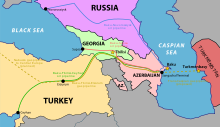South Caucasus Pipeline
| South Caucasus Pipeline | |
|---|---|

Location of South Caucasus Pipeline
|
|
| Location | |
| Country |
Azerbaijan Georgia Turkey |
| General direction | east–west |
| From | Baku (Sangachal Terminal), Azerbaijan |
| Passes through | Tbilisi |
| To | Erzurum, Turkey |
| Runs alongside | Baku–Tbilisi–Ceyhan pipeline |
| General information | |
| Type | Natural gas |
| Partners |
BP (28.8%) TPAO (19%) SOCAR (16.7%) Petronas (15.5%) Lukoil (10%) Naftiran Intertrade (10%) |
| Operator | BP |
| Commissioned | 2006 |
| Technical information | |
| Length | 692 km (430 mi) |
| Maximum discharge | 25 billion cubic metres per annum (880×109 cu ft/a) |
| Diameter | 42 in (1,067 mm) |
The South Caucasus Pipeline (also known as Baku–Tbilisi–Erzurum Pipeline, BTE pipeline, or Shah Deniz Pipeline) is a natural gas pipeline from the Shah Deniz gas field in the Azerbaijan sector of the Caspian Sea to Turkey. It runs parallel to the Baku–Tbilisi–Ceyhan pipeline (oil).
On 21 May 2006, the commissioning gas was pumped to the pipeline from the Sangachal Terminal. First deliveries through the pipeline commenced on 30 September 2006. Deliveries of gas from Shah Deniz gas field started on 15 December 2006.
On 12 August 2008, the pipeline operator BP closed the pipeline for the safety reasons because of the South Ossetia conflict. Gas supplies were resumed on 14 August 2008.
The 42-inch (1,070 mm) diameter gas pipeline runs through the same corridor as the Baku–Tbilisi–Ceyhan pipeline until Erzurum, where BTC turns south to the Mediterranean. It is 692 kilometres (430 mi) long, of which 442 kilometres (275 mi) is in Azerbaijan and 248 kilometres (154 mi) in Georgia. The initial capacity of the pipeline was 8.8 billion cubic metres (310 billion cubic feet) of gas per year. For the second stage of the Shah Deniz development, the capacity would be increased up to 25 billion cubic metres (880 billion cubic feet) by adding additional looping and two new compressor stations, costing $3 billion. As the pipeline has the potential to be connected to Turkmen and Kazakh producers through the planned Trans-Caspian Gas Pipeline, Azerbaijan has proposed expanding its capacity up to 60 billion cubic metres (2.1 trillion cubic feet) by building a second line of the pipeline.
...
Wikipedia
